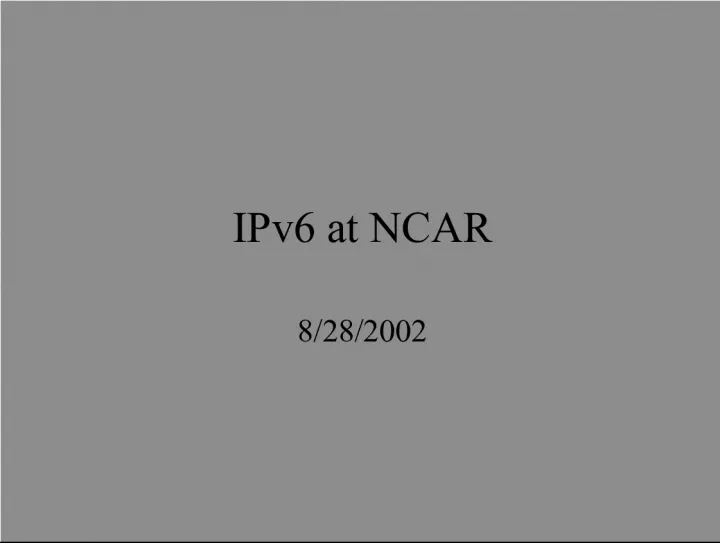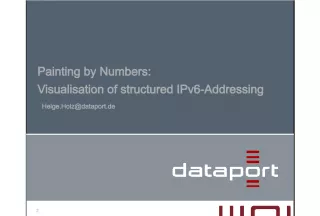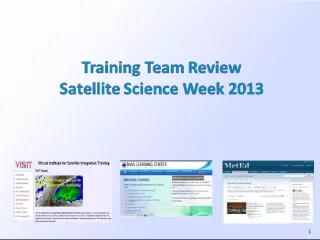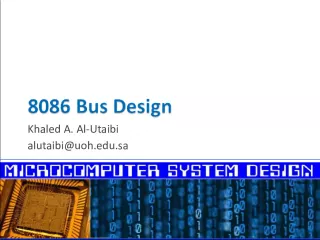Getting Ready for IPv6 at NCAR


Learn about the features of IPv6, why it's needed and how to use it. IPv6 is the next generation internet protocol that will replace IPv4. It will soon be available at NCAR.
- Uploaded on | 0 Views
-
 jeeny
jeeny
About Getting Ready for IPv6 at NCAR
PowerPoint presentation about 'Getting Ready for IPv6 at NCAR'. This presentation describes the topic on Learn about the features of IPv6, why it's needed and how to use it. IPv6 is the next generation internet protocol that will replace IPv4. It will soon be available at NCAR.. The key topics included in this slideshow are IPv6, internet protocol, address exhaustion, routing tables, security,. Download this presentation absolutely free.
Presentation Transcript
1. IPv6 at NCAR 8/28/2002
2. Overview What is IPv6? Whats wrong with IPv4? Features of IPv6 IPv6 will soon be available at NCAR How to use IPv6
3. What is IPv6? IPv6 is the next generation of the Internet Protocol. It will eventually replace IPv4, the protocol that we use today. IPv6 design started in 1993 A standard was created in 1998.
4. Whats wrong with IPv4? Address exhaustion Routing tables getting too large Security Dynamic addresses are inconvenient Mobile IP not well supported
5. IPv4 Address Exhaustion 4 billion addresses, but not really CIDR helps, but not enough NAT helps, but not enough New smart devices will need network addresses
6. Routing Tables Too Big 110,000 routes today, and growing Need more memory Need more CPU Have to handle more routing changes
7. Dynamic Addressing is Inconvenient NAT is a band-aid breaks some applications debugging nightmare DHCP helps Static addresses are really nice
8. Mobile IPv4 isnt good Hard to manage Clunky roaming
9. Features of IPv6 128-bit addresses Hierarchical addressing More efficient packet headers Security Auto configuration of end hosts Anycast Mobility IPv6 co-exists with IPv4
10. 128-bit addresses Sample IPv4 address: 127.117.8.203 Sample IPv6 address: 3FFE:0000:0000:0001:0200:F8FF:Fe75:50DF or 3FFE:0:0:1:200:F8FF:Fe75:50DF or 3FFE::1:200:F8FF:Fe75:50DF
11. Security 56-bit DES is supported by all IPv6 stacks New extended packet headers allow various encryption algorithms
12. Autoconfiguration IPv6 stateless autoconfiguration: the router and the host create an IPv6 address and a default route IPv6 stateful autoconfiguration: uses DHCP like IPv4
13. Anycast IPv4 has unicast, broadcast, multicast IPv6 has no broadcast (uses multicast) But theres the new anycast Sends a packet to the nearest of a set of hosts Like, send this packet to the nearest router that has a connection to the Internet
14. Mobility Mobile IPv4 exists in small deployments IPv6 has extended headers and Anycasting, which make Mobile IP easier Mobile IPv6 allows more efficient routing of packets to mobile nodes
15. NETS plans for IPv6 at NCAR FRGP now has native IPv6 to Abilene Establish native IPv6 from NCAR to FRGP Connect NCAR Juniper to a VLAN Experiment with IPv6 DNS Consider the security implications Offer IPv6 on production VLANs Consider an internal IPv6 routing protocol
16. How to use IPv6 Ask NETS about enabling IPv6 on your network Get an operating system that supports IPv6 Let the router assign your IPv6 addresses Use IPv6-aware applications to communicate with other IPv6 machines
17. Questions?










